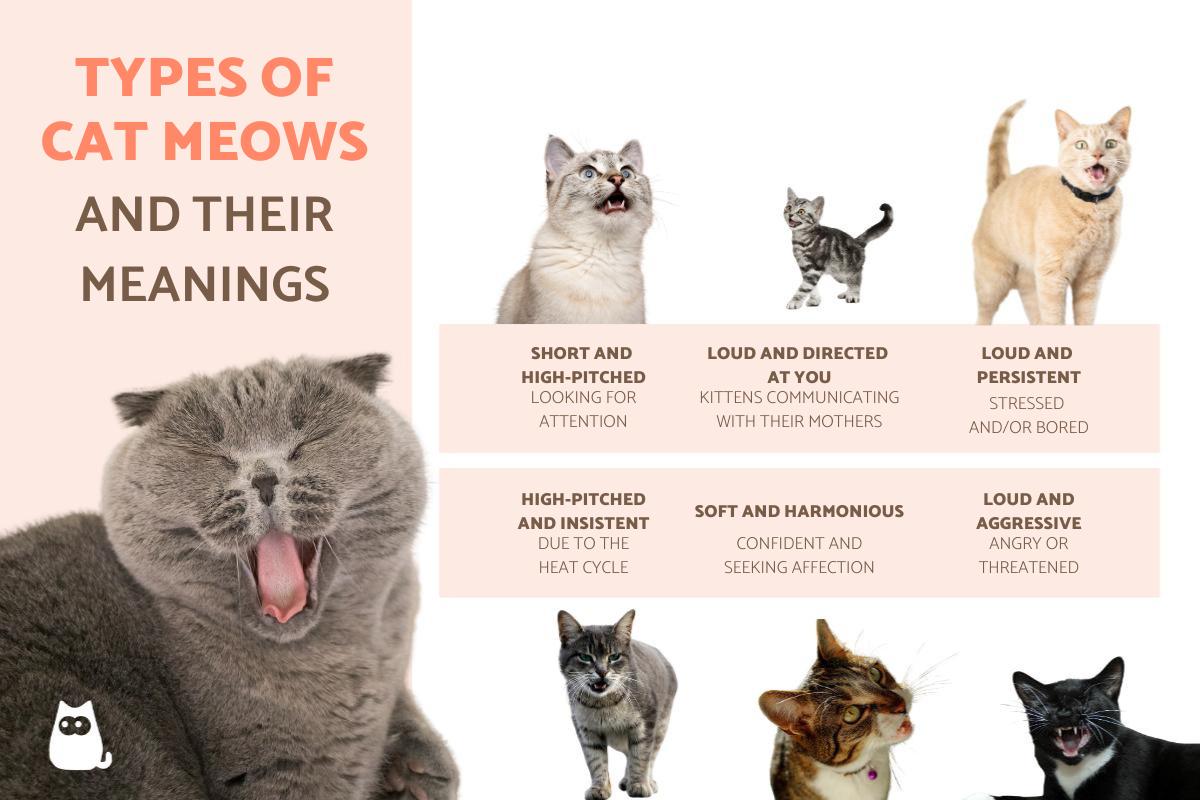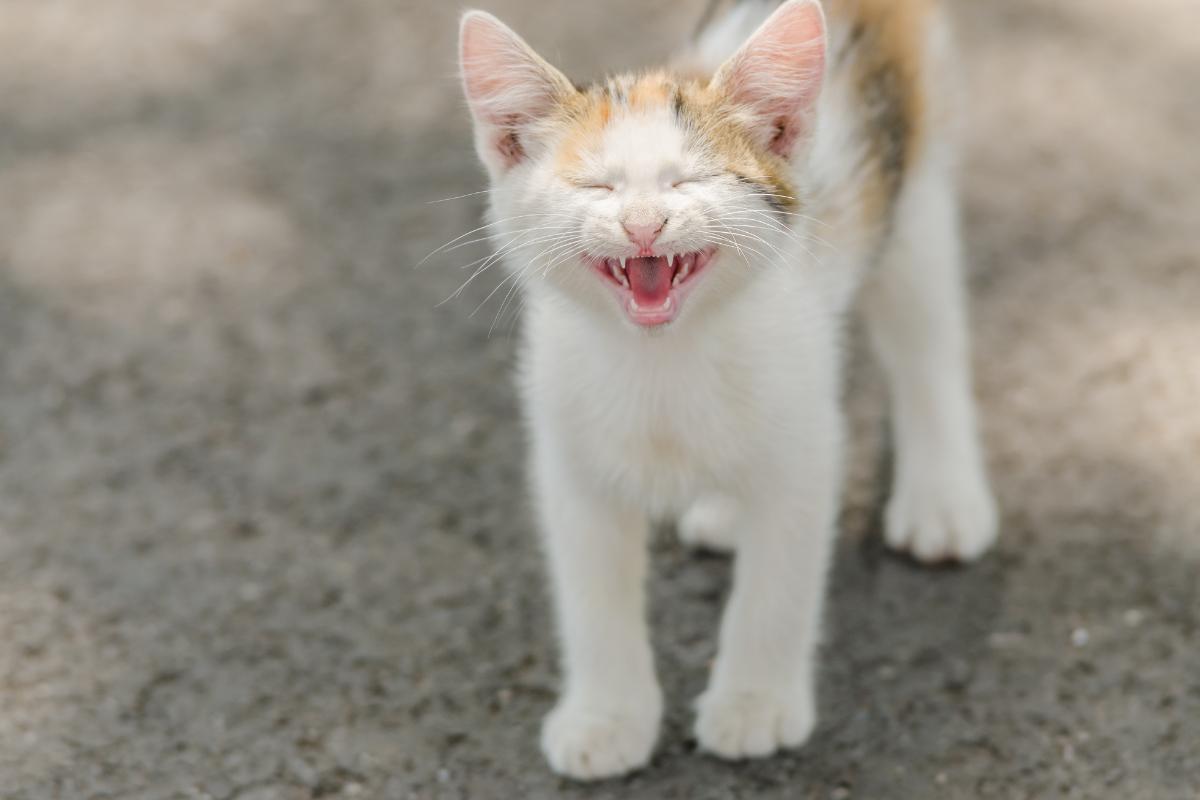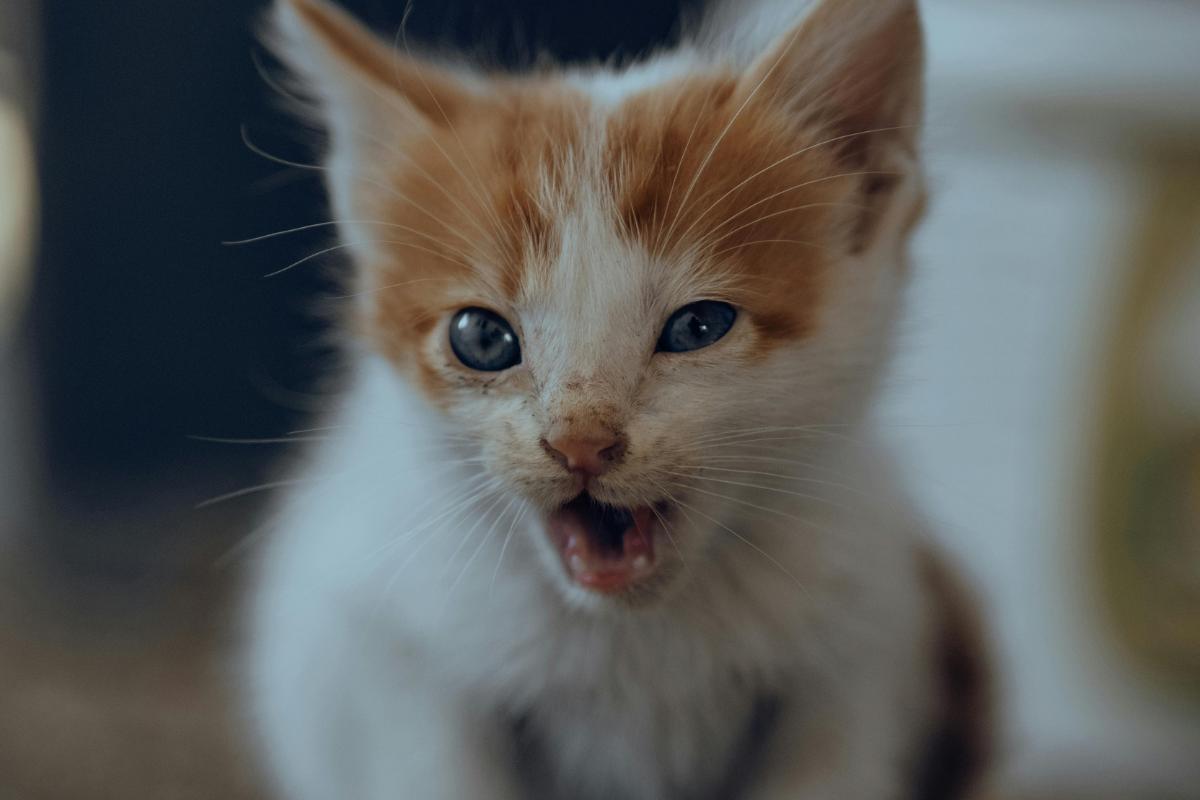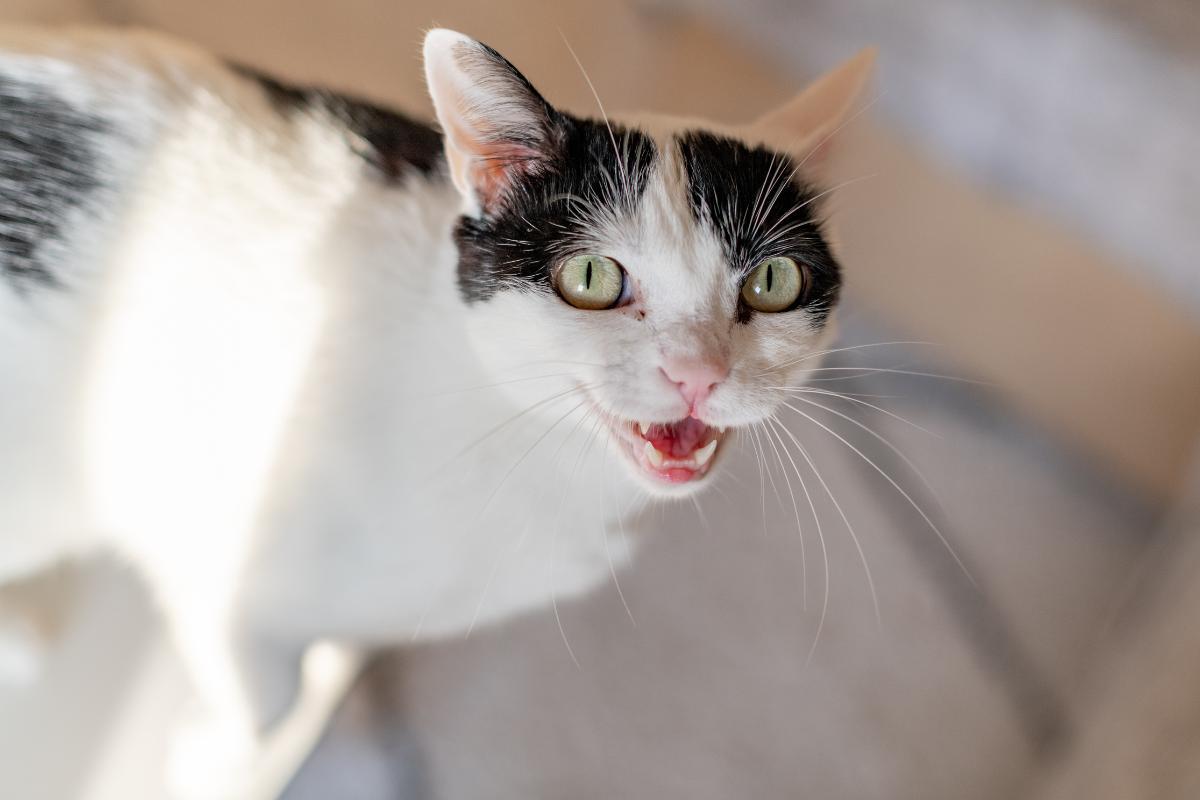Types of Cat meows and Their Meanings



See files for Cats
When understanding what a cat's meow means, we need to look at the context. Each meow will have its own meaning depending on factors such as health, well-being, presence of other animals or even the person to whom the meow is directed. Sometimes these meows can be questions, others they are statements. Meowing itself is a vocalization which is not common in wild cats once they become adult, but it is with domestic felines. This reveals much about the relationship human guardians have with their cats. To better understand what our cat is trying to say and how this can improve the bond between human and feline, AnimalWised shares 7 types of meows and their meanings.
1. Short and high-pitched meows
These types of meows are most associated with kittens. These short and high-pitched meows occur because the young cat is still developing their vocal cords, as well as simply learning how to make this sound appropriately. This is similar to how young children learn how to talk.
Kittens meow from around three weeks after they are born. They may seem to meow at just about anything, but they are simply responding to their new environment. Each of the various stimuli in their environment is a new experience and they meow as a method of response.
Kittens also meow as a means of communicating with their mother. Doing so allows them to communicate their needs and emotions. Kittens are altricial animals and rely on their mother for everything at the beginning of their lives. This includes everything from feeding to defecating. Meowing allows them to get their mother's attention, often in response to a perceived adverse situation. Such a situation may include:
- Hunger
- Cold
- Fear
- Loneliness
This type of meowing from kittens is considered a distress call. They are in need of something, so they meow to get what they want and to feel secure.
Meowing as part of learning
Meows also spark the curiosity of kittens. As they begin to realize they are capable of making this sound in a variety of ways, they implement it at will. This is a natural process that is part of the physical, cognitive and emotional development of kittens who are still learning their own feline nature.
It's important to note that kittens should not be separated from their mother before they are two or three months old. The mother cat is also responsible for teaching her kittens the basic principles of communication and social behavior, as well as the limits of play. This early learning process is key to preventing behavioral problems, learning difficulties and aggressive behaviors associated with play in young and adult cats.

2. Loud meow directed at you
As we have already states, cats begin meowing from around three weeks after they are born. Meowing is mainly directed at their mother, being used to petition for something they need such as milk or warmth. After they mature, this meowing sound is much less common in wild cats.
Domestic cats are much more likely to continue meowing vocalizations with their human guardians. It is a curious fact that belies something of the relationship between cats and humans. Even when adult, cats meow at us as if we were their mother. Cats know we are not a cat and that we are not their mother, but they do see us as a parental figure. We are also their main point of reference and their care providers.
In this way, cats will meow directly at us when they want something. What this something is will depend on the individual context. They could be hungry, want to play or simply desire a little affection. They may also be meowing to express a mood, such as loneliness, fear or happiness. Knowing what our cat wants in a given moment requires getting to know them well. This means learning their personalities and respecting their boundaries.
Learn more about what a meow might be telling you with our article explaining why my cat doesn't want to be picked up.
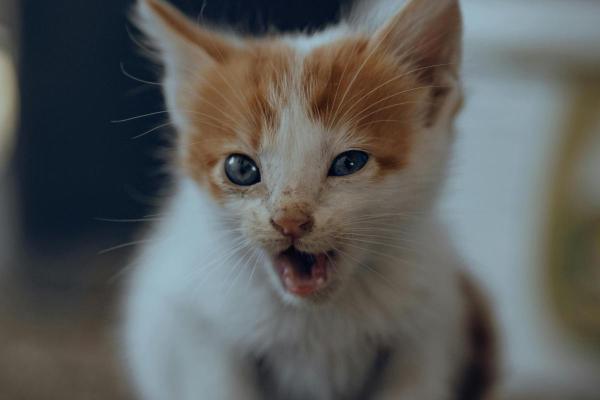
3. Loud and persistent meowing
As with many cat behaviors, meowing incessantly is likely a sign there is a problem with their well-being. Since meowing is a form of communication which mostly occurs between domestic cats and their guardians, they are taking up their issue with us. Regardless of the origin, the result is the cat becomes stressed.
Understanding the cause of stress requires looking at the bigger picture. Its origin may lie in environmental factors such as changes to their routine or the introduction of new family members. It could also be related to our behaviors, such as not providing them with enough attention or interacting with them in inappropriate ways. One of the most common causes is a lack of physical or cognitive stimulation, often due to a lack of environmental enrichment for cats.
It is also possible that physical health issues can result in the cat becoming stressed. They do not understand the changes occurring in their body which makes them feel very insecure. In this way, the cat is meowing us to alert us of the problem.
Since it can be so difficult to understand the nature of their problems, we should take the cat to a veterinarian if we are at all unsure. The first thing they will do is determine if they have a physical health problem. If this is ruled out, we will need to evaluate their environment, routine and care. If there is something missing, we need to address it. This is difficult and may benefit from the help of a feline ethologist.
If the issue is boredom, we will have to address this. Not only will we have to spend more time with them when we are present, we need to ensure their are stimulated when we are not there. This requires enriching their environment with scratching posts, climbing platforms, toys, interactive games and other accessories. You may even want to find out if they are meowing at your because it is a sign your cat wants another cat.
4. High-pitched, very loud and insistent meows
Another situation in which cats meow a lot and tend to appear more nervous or agitated than usual is when they have entered estrus. Also known as the heat cycle in cats, this is the time when a female is fertile and signals to a potential mate. This sexual behavior manifests in many ways.
Signs of heat in cats
Physical signs a cat is in heat include the engorgement of her vulva and even some bleeding. These are prompted by hormone production in the reproductive organs. They also change their behaviors, often seeking more affection from their guardians. Meowing is an important sign of heat in cats because it helps to notify males in the area that they are ready to mate, as well as signal their frustration to their guardians.
Some other signs of heat in cats include:
- Lifting the rear to expose her genitals
- Licking the vulva or genital area intensely
- Rolling on the ground more frequently
- Increased urine marking to release sex pheromone
These physical and behavior changes will continue until either mating occurs or the heat cycle finishes. This includes not meowing for this reason.
Male cats do not enter the heat cycle, but they do respond to females when they are in estrus. This includes meowing as a means of alerting females to their presence. When a male is not neutered, they will want to mate with a receptive female as soon as they sense their presence. They will also become more agitated and can even become aggressive. Stopping this behavior is one of the benefits of neutering a cat.

5. Soft and harmonious meow
If your cat approaches you, licks you or rubs against your face while purring and/or meowing very softly, this behavior usually indicates a high receptivity to contact. In other words, your cat is telling you this is the ideal moment to pet them, give them a relaxing massage or simply just enjoy their company. This is different to marking your for territorial reasons alone, although the two can happen concurrently.
We may see the cat kneads our belly with their paws, a behavior colloquially known as ‘making biscuits’. Like meowing itself, this is another holdover from when they were kittens. Baby cats knead their mothers breasts to stimulate milk production and encouraging bonding. Kneading us is a way for cats to feel close to us, as if we were indeed family. Meowing or purring contentedly commonly accompanies this behavior.
Many cats will maintain this behavior with their guardian long after they have matured. Doing so belies the strong bond between feline and human, showing they are safe and comfortable in our presence. Scent glands on their paws also release pheromones that generate a common odor. This allows the cat to feel more comfortable and secure in the company of that individual.
6. Loud and aggressive meow
If we hear a cat meowing as if they are screaming, it is likely a sign they are very angry about something. This is because the cat has reached a heightened state. It usually precipitates an attack and is one of the reasons why cats in the wild meow at other cats. It is also common for this sound to turn into a wailing noise as it is much different from many of the other types of meows in cats.
When a cat is meowing angrily, it is most common for them to also display other signs that indicate a defensive posture such as:
- Hair standing on end
- Folded ears
- Hissing
- Open mouth
- Rigid and erect tail
In these cases, the priority should be to calm the angry, upset or extremely stressed cat to prevent the situation from escalating. This could manifest in an attack with another animal or with ourselves if we have angered them for some reason. A cat often becomes aggressive because their warning signs have not been heeded. If it reaches the point where they are meowing angrily, it is not a good sign.
Calming an angry cat can be difficult. In many cases, it is best to simply leave them alone until they are able to be calm. If necessary, you can then address any of the underlying reasons why the cat was angry in the first place. This is something which will also benefit from the help of a feline ethologist if the problem persists.
Learn more about signs a cat is angry with our article explaining why a cat is vibrating their tail.

7. Abnormal meows
Changes in a cat's normal meowing can be caused by hoarseness. This is a result from damage to the larynx, whether from traumatic injury or a pathological origin. These pathologies can be in the form of infectious respiratory diseases caused by viruses or bacteria. Polyps or other types of tumors may also develop on the vocal cords to cause changes to their meow intonation. It can even be a result of chronic stress.
When a cat's meow is abnormal, it may present as horse, low-volume or practically silent meows. In addition to the cat losing their voice, they may also show more generalized symptoms such as:
- Vomiting
- Cough
- Fever
- Lethargy and/or weakness
- Loss of appetite
- Sore throat
- Isolating themselves
Causes of an abnormal meow may include:
- Respiratory diseases
- Metabolic disorders (e.g. feline hyperthyroidism)
- Tumors
- Trauma
In addition to being very painful, these problems can result in behavioral changes. If your cat meows strangely or you notice a change in their temperament, it's best to see a veterinarian quickly to rule out pathological causes. They can also help you to assess the need for treatment or behavioral therapy.
Understanding the meaning of the different types of cat meows will require looking at the context of this behavior. To learn more about some of the most common, check out our articles on why a cat keeps meowing at the door and why a cat meows when I pet them.
If you want to read similar articles to Types of Cat meows and Their Meanings, we recommend you visit our Basic education category.





